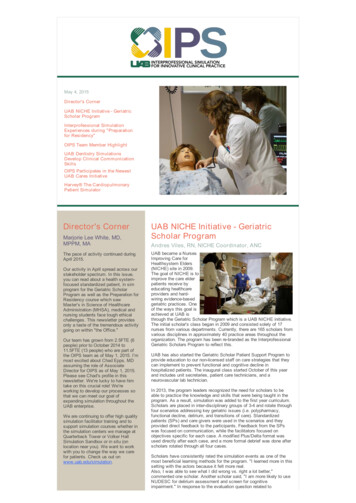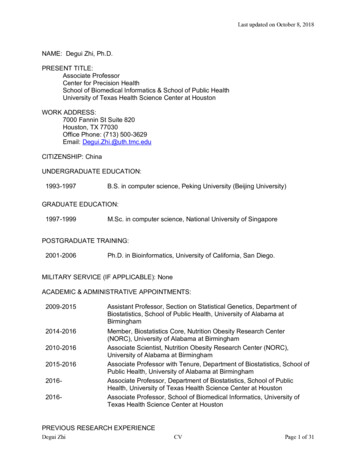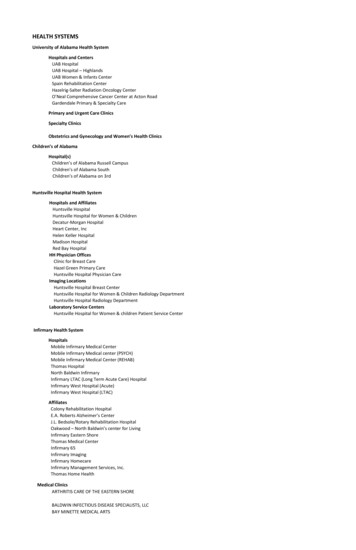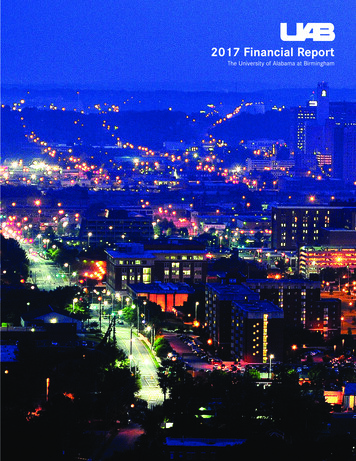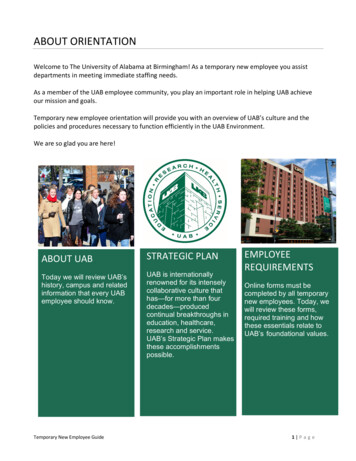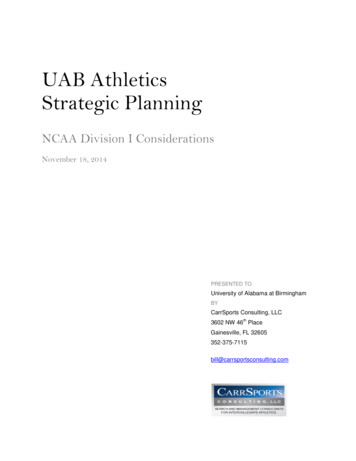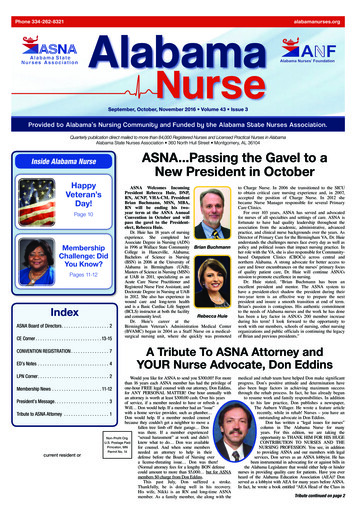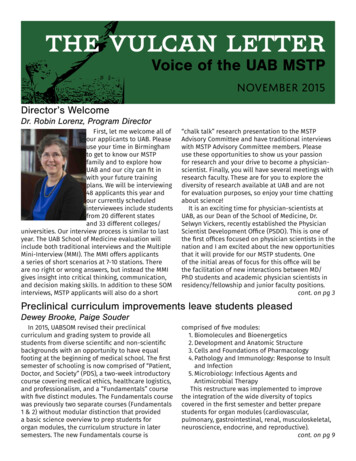
Transcription
the vulcan letterVoice of the UAB MSTPNovember 2015Director’s WelcomeDr. Robin Lorenz, Program DirectorFirst, let me welcome all ofour applicants to UAB. Pleaseuse your time in Birminghamto get to know our MSTPfamily and to explore howUAB and our city can fit inwith your future trainingplans. We will be interviewing48 applicants this year andour currently scheduledinterviewees include studentsfrom 20 different statesand 33 different colleges/universities. Our interview process is similar to lastyear. The UAB School of Medicine evaluation willinclude both traditional interviews and the MultipleMini-Interview (MMI). The MMI offers applicantsa series of short scenarios at 7-10 stations. Thereare no right or wrong answers, but instead the MMIgives insight into critical thinking, communication,and decision making skills. In addition to these SOMinterviews, MSTP applicants will also do a short“chalk talk” research presentation to the MSTPAdvisory Committee and have traditional interviewswith MSTP Advisory Committee members. Pleaseuse these opportunities to show us your passionfor research and your drive to become a physicianscientist. Finally, you will have several meetings withresearch faculty. These are for you to explore thediversity of research available at UAB and are notfor evaluation purposes, so enjoy your time chattingabout science!It is an exciting time for physician-scientists atUAB, as our Dean of the School of Medicine, Dr.Selwyn Vickers, recently established the PhysicianScientist Development Office (PSDO). This is one ofthe first offices focused on physician scientists in thenation and I am excited about the new opportunitiesthat it will provide for our MSTP students. Oneof the initial areas of focus for this office will bethe facilitation of new interactions between MD/PhD students and academic physician scientists inresidency/fellowship and junior faculty positions.cont. on pg 3Preclinical curriculum improvements leave students pleasedDewey Brooke, Paige SouderIn 2015, UABSOM revised their preclinicalcurriculum and grading system to provide allstudents from diverse scientific and non-scientificbackgrounds with an opportunity to have equalfooting at the beginning of medical school. The firstsemester of schooling is now comprised of “Patient,Doctor, and Society” (PDS), a two-week introductorycourse covering medical ethics, healthcare logistics,and professionalism, and a “Fundamentals” coursewith five distinct modules. The Fundamentals coursewas previously two separate courses (Fundamentals1 & 2) without modular distinction that provideda basic science overview to prep students fororgan modules, the curriculum structure in latersemesters. The new Fundamentals course iscomprised of five modules:1. Biomolecules and Bioenergetics2. Development and Anatomic Structure3. Cells and Foundations of Pharmacology4. Pathology and Immunology: Response to Insultand Infection5. Microbiology: Infectious Agents andAntimicrobial TherapyThis restructure was implemented to improvethe integration of the wide diversity of topicscovered in the first semester and better preparestudents for organ modules (cardiovascular,pulmonary, gastrointestinal, renal, musculoskeletal,neuroscience, endocrine, and reproductive).cont. on pg 9
Sloss is Boss! Sloss Music & Arts Festival 2015Hayden PaclPhoto Credit: Grace OliverRyanMcMonigleMS1Groups of attendees throughout the Sloss FestMusic & Arts Festival at the historic Sloss Furnacesin Birmingham, AL agreed that Sloss was “boss.”What made Sloss so boss, you ask? As a frequentfestival-goer, there were a number of unique factorsthat played into making Sloss Fest my best festivalexperience to date.1. The VenueWhat a venue! The clever design created a laidback environment in which I could really have somefun. The two main stages—Blast and Steam—werepositioned on opposite sides of an enormousclearing on the grounds of Sloss Furnaces (a nationalhistoric landmark), and the bands alternatedbetween them. This design meant several things: Sound checks for bands were a matter of minutes Scheduling conflicts were minimal You can watch one band perform from across thefield while you wait front-row for the next band If you so desire, you can catch all the action fromone spot, either in the grass in the center of theclearing or in the shade of a conveniently locatedstand of trees!Additionally, the incredibly unique Sloss Furnacesis open year-round for a number of other excitingevents, such as the renowned Sloss Fright Furnacehaunted house in October and the Local FlavorFestival—the premier food and wine festival inAlabama.2. The CrowdEver been enjoying a great show when you have toplay a game of “immovable object vs. unstoppableforce” with hordes of people squeezing into thetiny remaining nooks and crannies of personalspace between you and the people you’re standingaround? I generally find that this situation is myleast favorite aspect of festivals, but don’t worryabout it here. After tactically waiting an hour fora great spot for the band, Cage the Elephant—andagain the next day for the band, Primus—I didn’thave to fight anyone for my space. In fact, there waseven room to dance! This fun-loving, funky festivalcrowd was one of the most laid-back and boundaryrespecting crowds I have ever had the privilege ofrocking with. (Note: They can still get down! RyanMcMoniga was a key instigator in a mosh pit duringthe Primus finale—feel free to ask him about it.)3. The LineupThe lineup featured mostly folk and alternativerock artists. Over the two days of the festival, I sawsome sweet headliners—Modest Mouse, the AvettBrothers, Cage the Elephant—as well as smalleracts that fit in perfectly, including Young theGiant, Manchester Orchestra, theme song, Primus.Unfortunately, I missed some of the more funkybands, including Big Gigantic and Tyler the Creator,but I hear they brought the funk.4. The SideshowThere were a number of other things you couldfind yourself doing if not listening to music: Food and Drink: trucks and stands from Jim ‘nNicks BBQ, Steel City Pops, burger joints, and anumber of other vendors were present, as well asa beer garden and refreshment tent. Local Artisans: a number of homegrown artisanshad stalls, which made for an exciting art galleryand a place to find a truly unique gift or memorywhile supporting Birmingham’s creative vibe.cont. on pg 4
What happens in Nashvegas.SEMSS 2015Paige SouderThe 6th annual Southeastern Medical ScientistSymposium (SEMSS), a conference put on for MDand MD/PhD students by Emory, Vanderbilt, andUAB, was a treat for all in attendance. This year’sconference was held at Vanderbilt University inNashville, TN—a city with plenty of charm on it’sown. A number of UAB MSTP students presentedposters at the conference, and our own Fabio Raman(MS2) was selected for an oral presentation basedon his summer rotation (go, Fabio!). Several UABMD-only MS2s presented as well, representing thelarge percentage of the UAB medical school classinterested in research.Kristin Olson, former president of Equal AccessBirmingham (EAB; the UAB student-run free clinic)and newly inducted MSTP (GS1), led a group ofMSTPs involved with the clinic to present a poster“highlighting the incredible participation in bothvolunteering and leadership at EAB from MSTPstudents.who were involved in the founding ofthe clinic, and, in the last few years in particular,significant leadership positions.” Our posterdemonstrated how we use EAB to “not only provide aservice opportunity for budding physician-scientists,but also develop structured avenues outside ofSushma Boppana, MS2formal medical school curriculum to developskills important to us specifically.” This made fora popular topic of discussion among conferenceattendees, more so since our clinic is modeled afterVanderbilt’s student-run free clinic, Shades Tree.“We mutually agreed to follow-up with each other tostart talking on a regular basis to share successes,pitfalls, and to start touring each other’s clinics as away of training new students and getting new ideason how to run our clinics better.”cont. on pg 4Director’s Welcome, continued.This type of peer-mentoring is essential in thesuccess of not only individual students, but also inestablishing a healthy culture for physician scientistsat UAB. The establishment of PSDOs was recentlyrecommended in the Journal of Clinical Investigationarticle, “Rescuing the physician-scientist workforce:the time for action is now” (JCI 2015; 125:3742), whichI had the honor of co-authoring. Through our newPSDO and the MSTP, I plan on implementing many ofthese recommendations at UAB in the near future.We have also continued to enhance theinvolvement of students in our MSTP administrationwith the addition of one new student committee:the Individual Development Plan Committee. Thisnew group, along with our other established studentcommittees (Events, Communications, Griffin Society,CAMS, and SEMSS) and our student representatives,are excellent ways to become involved in your MSTP.My heartfelt appreciation goes out to all of theMSTP students who have been giving their time andenergy to making this a great MSTP. There are manymore than I can easily list, but a special thanks goesto 1) Muhan for helping to organize SEMSS 2015, 2)to those who have put their efforts into the newUAB APSA chapter and have gotten us recognizedby the national APSA (Alice and Tyler), 3) to theleaders of the Griffin Society for helping us receive ateaching innovation award and are now working oncollecting data for a publication on the impact of ourinnovative MSTP 795 Continuing Education Course(Katie, Stephanie, Alice, and Dr. Geisler), 4) to theorganizers of our fantastic retreat (Jeremie and Jon),and 5) to Paige and Hayden for their efforts with thisnewsletter, our blog, and our new “Sketches” series.Also, a congrats goes out to our Associate Director,Dr. Louis Justament, who was recently named theImmunology Theme Director and will be workingvery closely with our immunology focused studentsand the rest of the Immunology PhD students.Finally, our MSTP family and our program wouldnot be the same without the continuous supportof Randy and Jackie. A big thanks goes to them forall their hours of involvement in our program andour lives. As the African proverb states, “It takes awhole village to raise a child,” and I believe it is our“MSTP Village” that is raising each of us to becomegreat physician scientists. All of your efforts help tomake our MSTP a fantastic program and I am lookingforward to our next year together.
Sloss is Boss, continuedPhoto Credit: Grace Oliver Sloss Metal Works: a group ofworkers from the furnace weremelting down and pouring ironso close to you that you couldfeel the heat (For 20, youcould design your own mold forthe iron and they would pour itfor you with same-day pickup!)5. The PeopleThe only thing that couldpossibly make this festivalany better was the people. Igot to better know my MSTPclassmates during my first monthin Birmingham, before classeshad even started. Of the eightstudents in my cohort (MS1), seven of us made it outto Sloss Fest. A good number of the upperclassmenwere around as well, convincing me that my nexteight years with such an exciting and cohesive groupwill be balanced well spent!Suffice it to say, I will be at the 2nd annual SlossFest (July 16-17, 2016), and I hope to see you there!SEMSS 2015, continuedMSTP Insider: Get in the KnowIn addition to student research presentations,two keynote speakers and a number of “breakout”sessions were offered to provide students withopportunities to receive commentary on currentbiomedical issues and gain valuable insight ontopics specific to various levels in training. The firstkeynote speaker, Dr. James HIldreth, hopped overfrom Meharry Medical College in Nashville to discusshis research in HIV transmission and replicationpathways. His CV boasts accomplishments such asNIH Director’s Pioneer Award and his training wascompleted at renowned institutions such as Harvardand Johns Hopkins. The second keynote followedsuit with Vanderbilt’s own Dr. Ellen Clayton from theVanderbilt Dept. of Pediatrics—who also happens tohave a law degree—speaking on the intersection oflaw, medicine, and public health. She also did herIvy League rounds with degrees from Stanford, Yale,and Harvard. Breakout sessions included advice forundergraduates in applying to MD/PhD programs,early MSTPs on transitioning to graduate schoolyears, and late MSTPs on transitioning to clinicalyears and interviewing for residencies.Overall, SEMSS was an informative andcollaborative experience, providing studentswith an opportunity to mingle with studentsin all levels of training and explore VanderbiltUniversity and the great city of Nashville.Nashvegas, we look forward to seeing you soon,and welcome all next year to SEMSS 2016 at UAB!2015-2016 Applicants 48 applicants interviewed 20 states represented 43 colleges/universitiesCurrent Students 63 students (42 male, 21 female) 27 states represented Average MCAT—33 Average GPA—3.73 Average Step—233 Awesome pets (see pgs. 6-7)University of AL @ Birmingham MSTP running 24 years strong (since 1991) Top 30 rankings in multiple clinical specialties Newly developed Physician Scientist DevelopmentOffice headed by Dr. Lorenz Highest Level of Accreditation by LCMEBirmingham, AL Forbes 2015 #1 Most AffordableCity in the US Zagat’s #1 Next Hot Food City MAJOR downtown developmentin the works Outdoor recreation to the max
Open Access Articles: Changing Custom vs. Established ExclusionAnna Joy Graves, Josh CohenA scientist’s productivity is objectively measuredby their publications, both via quality and quantity.Appropriately, a myriad of academic journals havebecome available for scientists, and physicians, topublish their work and stay up-to-date on the latestfindings in their area of interest. For academicianswith university affiliation, access to these articles isreadily available via university-funded subscriptionsand interlibrary loan systems; however, the generalpublic is generally excluded from these articles (savethose with open access). There is currently a debateas to whether this doctrine of public exclusionis the best means of scientific communication.Two of our MSTP students in the graduate schoolphase, in which this issue is particularly relevant,offer opposing views in the debate of whether allscientific research should be made open access.Proposition: In its most noble form, thegoal of science is to light the world, tounderstand and explain nature and usethat understanding to better humanity. Sharingdiscoveries and results with other scientists andlaypersons is an integral part of this mission,yet too many are left without access to scientificresearch, which is held behind publisher pay-walls.The majority of scientific research is publishedin journals that require exorbitant subscriptionfees or may charge over 30 for access to singlearticles. This leaves those without a major universityaffiliation virtually cut off from scientific discourse.Not only does this go against the highest ideals ofscientific endeavor, it is wholly unfair. Most basicscience research is paid for with US tax dollars.The public has a right to access the results ofresearch they funded. Indeed, in 2013, the Obamaadministration issued a memorandum requiringfederally-funded research to be made open accesswithin one year of publication. However, I believewe can—and should—do better than this by makingall published scientific research freely accessible,immediately. Open access journals have proventhat his can be a viable model by passing the costof publishing from the consumers/readers to theresearchers/authors. The claim against widespreadadoption of such a system is that it would be toocostly for researchers. At a time when researchbudgets are already stretched thin, we can’t affordto spend money on publishing. I find this argumentunconvincing. While I am always a proponent formore science funding, I think we can make dowith this added cost. We spend thousands or tensof thousands of dollars on animals, cell cultures,antibodies, assays, and next-generation sequencing,surely we can budget 2000 for the publicationof our efforts. Additionally, the money saved onjournal subscription fees by universities could bere-invested in research or used to offset the cost ofpublishing for faculty. Publishing open access is notonly affordable, but it is also the right thing to do.Josh Cohen, GS3Opposition: More information is not alwaysbetter. If the quality of the informationis suspect – or worse still, manufacturedand distributed for a price – then we should bewary of supporting any process that produces thatinformation. In order for open access journals tomake their articles widely available to readershipwithout charging a price, the manuscript authorsare levied a fee. Many respected journals with arigorous review process do this legitimately; feesare used to cover the costs of hosting their journalsonline and hiring expert editorial and administrativestaff. The trouble is, a growing number of predatoryjournals have seized upon this publication methodto make a quick buck – and are successful in doingso. One librarian, Jeffrey Beall, has compiled a listof over 400 such publishers (http://scholarlyoa.com/publishers/). These journals often have namesthat are nearly identical to those of reputablejournals and are thus sometimes indistinguishableto academics, much less the general public. Somemanuscript authors unknowingly submit theirarticles and are later hit with a hefty fee uponacceptance; others consciously select these journalsand are willing to pay the fee in order to pad theirresume or publish pseudo-science. More worryingis the concern that the untrained public readershipmay not be able to disentangle quality from junkscience. They may seize upon articles that supporttheir stance (need I say the word “vaccine”?) orbe genuinely beguiled into thinking that everyarticle published in a research journal is legitimate.Ultimately, the current model of institutions orindividuals paying for the right to read a scientificarticle – while subsidizing or waiving fees forresearchers in developing countries who may nothave the resources to access it – puts scientificinformation in the hands of people who knowhow to use it. It also severs the direct financial tiebetween author and publisher, either of whom mayhave underlying motives for supporting a pay-forpublication model.Anna Joy Rogers, GS3
Ruff day? There’s a dog for thatPaige Souder and the MSTP pet parentsMan’s best friend is an understatement. If youhave a pet, you know the bond that forms betweenyou and your canine (or feline, or other) companionis distinct, singular.exceptional. I can attribute tothe rewarding experience of having a pet—even inmedical school—and felt it necessary to give theother MSTP pet owners a chance to show off theirpride-and-joys (cue Stevie Ray Vaughn sound-track).Brahm Weaver: the Country-ClubberBrahm is a 4.5 year-old German Rottweiler whoenjoys sunbathing, spectating tennis, tug o’ war, andMuhan’s dog, Shadow (see below). Brahm’s proudowner is Alice Weaver, a GS3 who enjoys sunbathingand tennis-spectating with him.Shadow Hu: the TravelerShadow is an almost 6 year-old flat coatretriever who is a proud alumni of “Adopt a GoldenBirmingham.” She has been with her owner Muhan(GS1) for 2 years and in that time has tranformedfrom a scaredy-cat to a lovable attention-seekingcompanion. Her favorite activity is hiking; she’scompleted her exploration of the Southeast and haseven walked across the border at Niagara Falls!Mars Zipperly-McLean: the KingMars Maximilian Zipperly-McLean is a rescue dogfrom Charleston, SC. He is approximately 5 yearsold, and he is believed to be a rottweiler/bordercollie mix. Known to his subjects as “King Mars,” heenjoys taking long walks around his ever-expandingkingdom, running wild in the mountains, trying newethnic foods, and modeling his extensive bandanacollection. He also loves pawing through the worksof Ernest Hemingway, and considers himself anavid soccer player. A ferocious warrior, he fearlesslydefends his kingdom from the daily onslaught ofthreats, including the mailman, the pizza deliveryguy, neighborhood cats, and an army of squirrels.Maya Souder: the Free-SpiritMaya is a 1 year-old schnauzer-mix who uses all ofher 8 lbs of weight for optimal trouble-making andplaytime. She enjoys hiking, escaping from the yard,eating carrots, and playing with Mars, Shadow, andKona (coming up). Don’t let her small size fool you,she’s spunky to the core and will stand her own nomatter the challenge. And don’t expect to beat her ina foot race—she can run.
MSTP DogsKona Stoyka: the DestroyerKona is a 1 year-old shepherd mix. She wasadopted her from the Humane Society when she was4 months old, who thought she was a shepherd/lab mix, but stopping growing once she hit 40pounds. Her parentage is as unknown as the limitsof her energy. Her favorite things to do are to learnnew tricks (this month’s trick: army crawl), destroy“ indestructable” dog toys, play with other pups, andgo hiking. Her owner, Lindsay, loves trying to keep upwith her in her spare time.Asa Cohen: the RevolutionaryAsa is a 2.5 year-old pit bull. Her interests includetug o’ war, food, and testing the limits of modernbehavioral theory. Her owner, Josh, is grateful for herhelp in training him to become the best behavioralneuroscientist he can be.Kobe Bean Lever: the All-AmericanKobe is a 2 year-old boston terrier. Jeremierescued him last year and it’s been true love eversince. Kobe loves to play in the yard, play in thehouse, play in the park, and play anywhere elseJeremie dares to venture.Callie Robert: the PrincessCallie is a 6.5 year-old maltese that weighsa whopping 4.5 lbs, winning the award for oursmallest pup. Her favorite thing, besides her ownerStephanie, is her “Bug.” Pictured below with Callie,Bug is a blue ball with bug eyes (hence the name)that she has loved ever since they met when she was7 weeks old and they were about the same size. Eventhough Callie has outgrown Bug, she has remainedloyal, refusing to go anywhere without him or loveany other toys.Hank Stanley: the HeartbreakerHank is a 5(ish) year-old Australian Shepherd. Hewoos all the ladies with his dashing blue eyes andenjoys playing fetch and running around outside. Heis oh so fluffy and oh so lovable.
Grant Writing: Tackling the F30/F31Anna Joy RogersBeing a physician scientist means being a masterof many trades. Some lessons are best learnedin the classroom, like statistics and molecularpathways. Others skills, like scientific reasoningand experimental techniques, can only be properlylearned in a lab. Writing a manuscript is a skill thatcomes after reading many papers and co-authoringa few before serving as a lead author. Writing agrant, however, is a different ball game. You onlylearn to hit when you’re up to bat.I had that opportunity this spring when I decidedto submit an F30 Predoctoral MD/PhD IndividualFellowship grant proposal to the National Institutesof Health. (In reality, the decision was made for me;the MSTP rightly requires that every student submita grant proposal precisely because that’s the onlyreal way to learn this essential skill. We do have aclass that teaches the mechanics of grant writing,but there is nothing like trial by fire.)The first step to grant writing is knowing the“why.” If you aren’t convinced that your projectis worthwhile, the reviewers won’t be either. Thesecond step is to have a good overview of all themoving parts of the grant application. For the F30/F31, this is how I broke it down:1. The Research PlanThis is the meat of the application. It is comprisedof the “Specific Aims” page and the six-page“Research Strategy.” The former is the equivalentof a manuscript abstract in that it contains asuccinct project justification and outline. The latteris where you get to expound on your project usingseveral standard categories: scientific significance/rationale, innovation, design/methods, and expectedoutcomes.2. The Training PlanThis section is unique to research trainees whohave yet to achieve independence as investigators.This section is easily relegated to being written afterthe research plan, but in reality reviewers are toldto place almost equal weight on both sections. Theywant to know that they are funding someone whohas long-term potential, not just a great dissertationproject. The training plan is comprised of youroverall goals for this fellowship and your careerand the activities other than research that youhave planned with the grant money (such as takingclasses, assistant teaching, and attending seminarsand conferences). Make sure to weave this trainingjustification throughout your application.3. Supporting Documents that You WriteReviewers need to know that you have thesupport system in place to conduct your research.This section comprises mundane, but necessary,components such as a cover letter, ethicalconduct of research/institutional review boarddocumentation, and a description of the mentorship,facilities, equipment, and institutional supportsystems in place that will ensure your success.4. Supporting Documents that Others WriteIn any application, it is crucial to know upfrontwhat you have to wait on others to assist youwith. This section has three components thatother parties write entirely: letters of reference, adocument written by the training program director(in our case, Dr. Lorenz) describing how the programis suited to meet the objectives of the fellowship,and biosketches of your mentors describing theiracademic qualifications. This section also has onecomponent that you write in conjunction with yourmentors to describe how their skill set will guide youthrough your training plan. In my experience, it wasan iterative process that took much more time thanexpected.5. MiscellaneousFinally, there are a lot of minor pieces ofinformation that you’ll need. These include howmuch money you should be asking for and yourmentors’ eRA Commons IDs among others. Don’tworry too much about these aspects of your grant,but do recognize that because of them the NIH“due date” of the application isn’t your deadline.UAB needs time to process your grant and take careof these details for you, so they will require thatyou submit it to them at least ten business days inadvance. Make sure to plan for this buffer time!In conclusion, there really is nothing like writingyour first grant application. It requires you tosharpen your research question to a point, thinkclearly about how your project and training plancontribute to your career plans, and performa balancing act between boasting about pastsuccesses and demonstrating how you need thefunding to build on your weaknesses.I could give you pages of advice, but ultimatelythere’s only one way to learn grant writing. Just do it.
AwardsNew Members of the Homeowners Club! Elizabeth Ma: 2 place StudentInvestigator, Obesity Week 2015& Pat Simons Travel Award Alice Weaver & Tyler McCaw:Winning poster, UAB Researchand Innovations in MedicalEducation Week Brian Warmus & Kristin Olson:2015 Gold Humanism HonorSociety Inductees Morgan Locy*, Anna JoyGraves*, Heather Allen,Vincent Laufer: UAB MedicalStudent Research Day OralPresentations (*Winner) Carson Moseley, Muhan Hu,David Figge: UAB MedicalStudent Research Day PosterAwardsnd Garrett Brinkley Crestwood Sushma Boppana Highlands Emma Dean Crestwood Ryan McMonigle Homewood Jacelyn Peabody Vestavia Brandon Pope Pinson Paige Souder Crestwood Morgan Zipperly CrestwoodWe have new doctors in thehouse! Congratulations to themboth.onWARD they go! Jennifer Stanley, PhD Jarrod Meadows, PhDAmelie PepinDaugher of Mark PepinDissertationsMaisha Meifong RogersDaugher of Anna Joy RogersCome on over, BabyCurriculum Changes, continued.Though the structure of organ modules is largelythe same, input from student course reviews hasbeen taken into account to improve the details ofcourse implementation. These include keeping goodlecturers and course directors, replacing less goodlecturers and course directors, improving quiz andtest questions, and targeting content to Step 1 (thesuper important board exam) relevant topics.Further, lecture hours were reduced by 50% toprovide more space for self-directed and teambased learning. These modes of learning providestudents with an opportunity to identify, analyze,and synthesize information relevant to their currentlearning needs and assess the credibility of variousresources—this is an important skill considering thewealth of resources available to medical students.They also stimulate collaboration between studentsby allowing them to share information with peersand supervisors, and to receive constructivefeedback. The previous year, lecture attendance wasmade non-mandatory, giving students the freedomto attend lectures or listen to lecture recordingsvia Echo360, an online lecture capture system.All lectures are available for online streaming ordownload within a few hours of the original lecturerecording (bonus: recorded lectures can be spedup, paused, or slowed-down to fit the viewer’spreference).Lastly, grading was restructured to a purelypass/fail (P/F) system in the first semester (PDSand Fundamentals) without percentiles or honors,and a P/F Honors system for the eight organmodules. Several medical schools across thecountry have adopted similar grading systems,which promote an environment of cooperation,rather than competition, among students. Look foran upcoming student debate on the incorporationof the P/F grading system at our blog, Unabridged—unabridgedmstp.wordpress.com (shameless plug).Overall, these curriculum changes have enhancedthe preclinical experience for MD and MSTP stu
UAB and our city can fit in with your future training plans. We will be interviewing 48 applicants this year and our currently scheduled interviewees include students from 20 different states and 33 different colleges/ universities. Our interview process is similar to last year. The UAB School of Medicine evaluation will

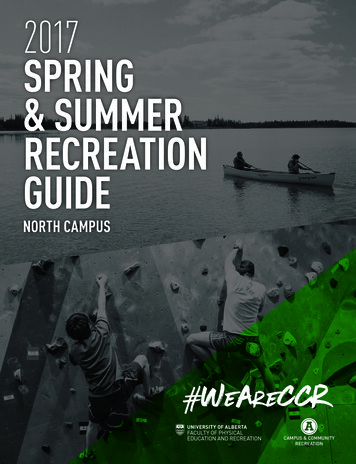
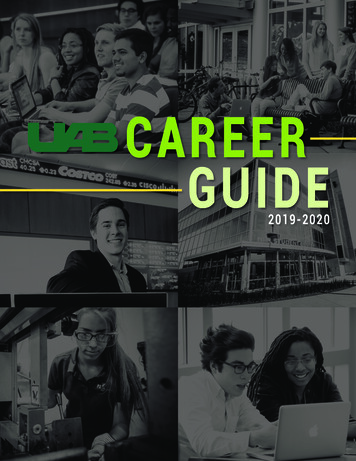
![Welcome [ uab.edu]](/img/56/pre-arrival-guide.jpg)
